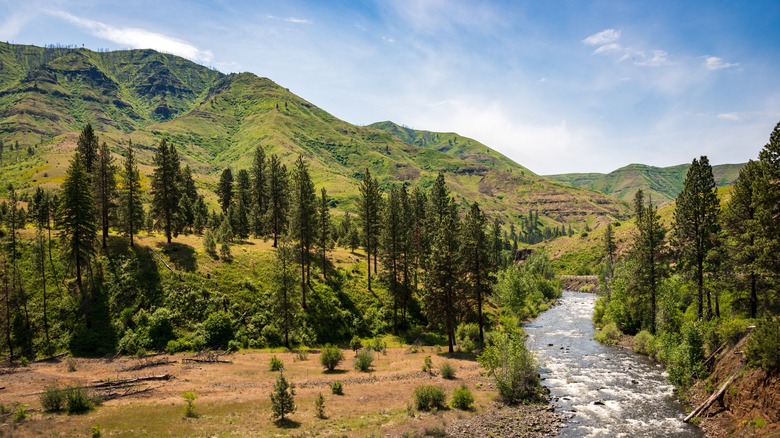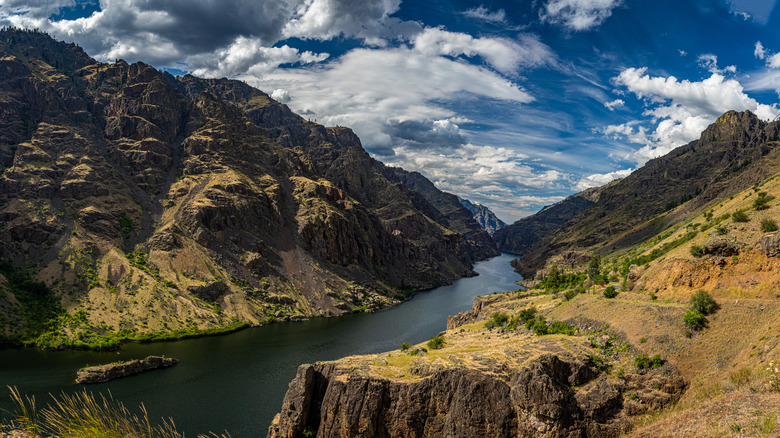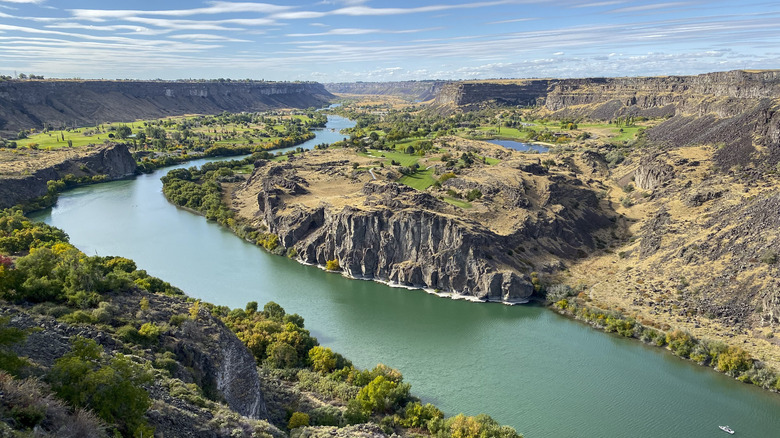Reaching The Deepest Canyon In America Is A Forbidding And Remote Wilderness Adventure
Straddling the Idaho-Oregon border is Hells Canyon, North America's deepest river gorge. Surpassing even the Grand Canyon in depth, this over 650,000-acre natural wonder, designated as the Hells Canyon National Recreation Area in 1975, offers breathtaking vistas and diverse landscapes. Carved by the Snake River, the canyon reaches a maximum depth of nearly 8,000 feet, making it almost 2,000 feet deeper than the Grand Canyon.
The Snake River flows through the Hells Canyon National Recreation Area, forming the boundary between Idaho and Oregon. Within this vast wilderness, wildlife thrives, offering visitors the chance to spot bighorn sheep, elk, mountain lions, rattlesnakes, bobcats, and various bird species. The canyon's dramatic topography, with the Wallowa Mountains of Oregon on one side and the Seven Devils Mountains of Idaho to the other, creates a diverse range of ecosystems from alpine meadows to arid canyon floors.
As the Snake River runs through the area, it is no wonder that Hells Canyon is a popular watersport destination. River trips through the canyon typically run from May through late September, with each season offering different experiences, so the best time to visit depends on your preferences. Spring and early summer, from May to early June, bring higher river flows due to snowmelt, ideal for anyone wanting to partake in intense whitewater adventures, while mid-June through August offers prime rafting conditions with warmer temperatures. Fall is an awe-inspiring time to visit national parks, so it is no wonder that September trips are favored by many for the changing colors and crisp nights, while still offering warm water and exciting rapids. When planning your visit, keep in mind that the area's rugged terrain and remote location require careful planning and preparation.
White water adventures in Hells Canyon
Hells Canyon's geological history is as fascinating as its present-day landscape. The canyon was formed by the great ice age floods approximately 14,000 years ago, leaving behind a river bottom that now serves as the foundation for Hells Gate State Park. At the park's southern end, visitors can observe basaltic columns from the Pomona flows dating back 14 million years, offering a glimpse into the area's ancient past.
The Snake River, which carved this impressive gorge, flows through multiple designated sections within the canyon. The 31.5-mile stretch between Hells Canyon Dam and Upper Pittsburg Landing is classified as a Wild river section, featuring rapids ranging from Class II to Class V. This section also boasts the canyon's most dramatic depth, measuring 7,913 feet from the river at Granite Creek rapids to the peak of He Devil Mountain in Idaho's Seven Devils range.
Downstream from the Upper Pittsburg Landing, a 36-mile Scenic river section extends to the Oregon-Washington state line. Although this portion is designated as Scenic, the shorelines remain largely undeveloped, preserving the area's nature. The last public boat launch and landing area is at Heller Bar, located at river mile 168.5, providing access to this remarkable wilderness.
Hiking Hells Canyon
Hells Canyon offers a wealth of outdoor activities for adventure seekers of all levels. Unsurprisingly, river activities are a large draw, but Hells Canyon also provides approximately 360 miles of hiking trails that vary in difficulty, from moderate walks along ridges and benchlands to extreme climbs up steep slopes. Visitors can also enjoy camping, horseback riding, and guided trips with llamas to help carry gear, and even indulge in a romantic national park stay further along the Snake River.
Hiking in Hells Canyon offers a spectacular experience, providing hikers with dramatic landscapes and diverse ecosystems to explore through easy walks or challenging multi-day backpacking trips. The Hells Canyon National Recreation Area includes the over 210,000-acre Hells Canyon Wilderness, where hikers can find solitude among towering peaks, steep canyon walls, and breathtaking views. For those seeking a more challenging adventure, the 56-mile loop trail starting from Freezeout Saddle offers a comprehensive tour of the canyon's geography. This 4- to 6-day route can involve thousands of feet of elevation gain and loss, depending on the exact route, and near-complete solitude.
If you prefer a guided hiking tour, Hells Canyon Adventures offer a range of experiences led by knowledgeable guides who can enhance the hikes with their insights into the area's history and ecology. Various other companies also provide guided hiking trips, including multi-day hikes aimed at beginners and experts alike.


